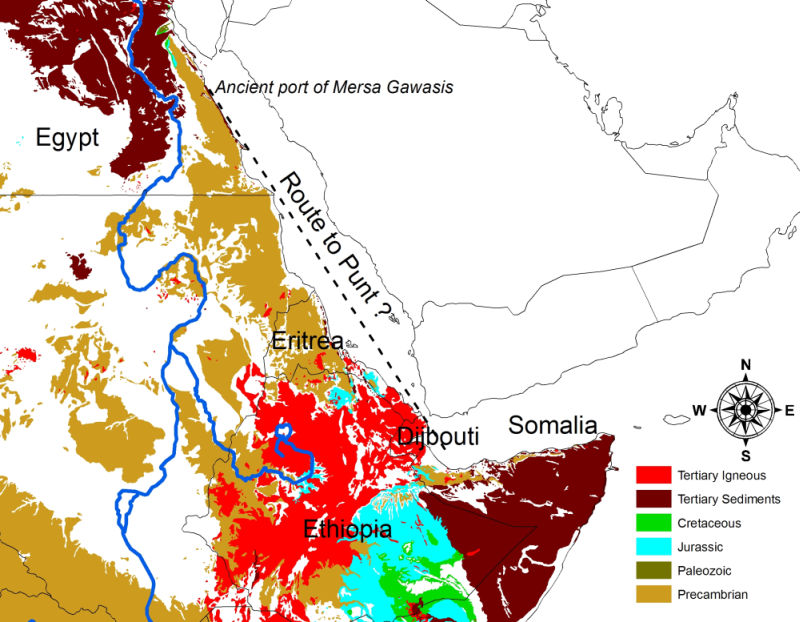The Yoruba claim kinship to ancient Egyptians, and similarity to the language.
Some words common to Yoruba and Ancient Egytpian:
name ..... ran
seed ..... naprit
water ..... miri
evil ..... bu huru/bu buru
pot; cup ..... apoti
yes; nod head ..... hen
no ..... enen
concealed ..... amon
elevated ..... hor
silvery fish ..... fahaka
to wipe, erase ..... nu
E: Oni = a form of Osiri(s) Y: Oni = king
E: Oba = to direct, captain Y: Oba = king
-----
And more subtantially some from J. Olumide Lucas' book:
Examples of AE survivals in Yoruba:
Yoruba - - - - Ancient Egyptian
Inoki............Noki-t "fabulous beast"
A-gu-ta(n)...Ha-khu-ptah
O-ni.............Au-nu "Crocodile"
Saluga.........Salug "god of wealth"
ibatan..........Bahtan "compatriot"
amon...........amon "to hide/concealed"
Wu...............Uu "swell"
Miri...............Miri "water" dazzle(of water)
Riri...............Ririt "dirty (like a hippo)"
Ade..............Ade-f "crown/plumes"
Ako...............Ak "male"
Abo...............Ab "female"
Ala................Ala "boundary - Obatala==King of Nile"
A-ke..............qe-h "axe"
a-dua............dua or tua "prayer"
a-ru-gbo........ru-ba "evening of ba i.e. later stage of life"
Sadu.............Zaddu "abode of the dead"
I-re................Re "That whis is good, goodness"
Ko.................Qo-t "build"
Wombia.........nubia "you, a Nubian" - derogatory - "a covetous person"
Note:
(O-ni is pronouced with an 'Or' sound)
The sacred animal of the city of On (Aunu) survives in the word O-ni, "crocodile", a name used as the title of the paramount King in Yorubaland, i.e., the Oni of Ife.
The Yoruba phrase "apa amu sua", which means "an unthrifty person" is derived from three AE words:
Apa - "he who belongs to the house i.e. servant"
Amu - one of the Asiatic tribes engaged in domestic service in Ancient Egypt
Sua (Sua-nit), a nome in AE. The phrase is a comtemptuous term which preserves the idea of the wastefulness of foreign domestic servants in AE who hardly knew the value of crockery and other articles they sometimes smashed to pieces.
The word "bu" in AE means "place". This word survives in Yoruba vocabulary:
"ki bu e e" means "what place are you going?"
"ibudo" means "a place to settle"
"ibusun" means "a place to sleep"
"ibu-joko" means "a place to sit"
"ibu-so" means "a station"
"a-bu-le" means "premises"
The connection bewteen the two languages is so close that it is quite possible for one to help in determining the siginifcance of words whose meanings have not yet been definitely ascertained or have become obscure in the other!
There is a survival of customs
- Religious beliefs. Most of the prinicpal gods are well known: Osiris, Isis, Horus, Shu, Sut, Thoth, Kepera, Amon, Anu, Khonsu, Khnum, Khopri, Hathor, Sokaris, Ra, Seb, the 4 elmental deities etc.
-- Ra survives in name only, but the words Irawo (star), rara (swear by Ra), rara (dwarfs - AE mythological Danga dwarfs that hailed the daily arrival of the sun-god) preserve the idea.
-- The idea of a future life and that of judgement after death
-- The deification of Kings.
-- The importance attached to names. A man's name is supposed to have a real force in determining his character. Names are not given haphazardly, but acording to prevailing circumstances at the time of birth.
-- Strong belief in a future life. The AE and Yoruba ideas are identical. The Yoruba word for the verb "too die" is Ku, i.e. to become a luminous spirit. The Egyptian word Khu, or the luminous part of a man, "is a spark of that divine intelligence which pervades the world and to which it must return"
- Polygamy - similarity in the position of the first wife and her rights and privileges
- Burial customs. Previous to burial the corpse in Yorubaland is dressed like the Egyptian mummy. In the case of the burial of the king, the king slaves must be buried with him, and his Chief Officers and wives must die on the day of the burial. The king will require the services of his dependents in the next world. The British influence has put an end to such practices. Ushebti figures are now substitued for living persons.
-----
http://thenile.phpbb-host.com/ftopic230-0-asc-0.php
Somalis have to produce more hard evidence than the Yoruba.
Oh, I just remembered ancient Egyptians used to practice incest, with kings marrying their sisters. I don't believe ancient Somalis used to do that.












